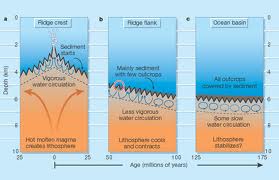Analysis of seafloor sediment reveals lower oxygen levels in the ocean when the planet heated up 55.9 million years ago
Digging into our planet’s past could help us prepare for a hot future. One dramatic spike in historical temperatures, the Paleocene–Eocene Thermal Maximum (PETM), occurred around 55.9 million years ago. That time was marked by changes in ocean productivity, the water cycle, ocean acidification and land animal migrations. Now a new study by researchers in the U.K. confirms the ocean held less dissolved oxygen.
Similarly, low oxygen zones caused by modern climate change threaten marine life and humans who depend on the ocean for food. Deoxygenated zones in the North Pacific and tropical oceans have expanded in the last 50 years, according to a 2009 review from researchers in Europe and the U.S.
To peek into ancient climate for a possible clue to our future, Alex Dickson, a paleoceanographer, and his colleagues at The Open University in England analyzed sediment samples gathered by the Integrated Ocean Drilling Program, an ongoing international marine research project. The sediment cores were pulled from the Lomonosov Ridge in the Arctic Ocean. The team estimated the extent of low-oxygen seawater in global oceans by measuring the ratio of molybdenum isotopes in the sediment samples. The ratios “imply a small but significantly higher level of low-oxygen marine environments compared with the present day,” the team wrote in the July issue of Geology.
The marine sediment the researchers analyzed is “black, gritty” and sulfur-rich, oxygen poor. The proportion of oxygen-rich and oxygen-poor seafloor sediments regulates the balance of molybdenum isotopes. In well-oxygenated environments, light molybdenum isotopes adhere to the surface of manganese oxides, Dickson explains. But that process, called adsorption, happens slowly. A single molybdenum atom can hang around in the ocean for several hundreds of thousands of years on average before it is adsorbed. In low-oxygen but high-sulfide marine sediments, however, all molybdenum isotopes are taken up quickly, regardless of weight. As a result, sulfur-rich, oxygen-poor sediments reflect the composition of molybdenum isotopes in seawater during the time the sediment was deposited. Once the seawater ratio has been estimated, it gives researchers a way to calculate the extent of differently oxygenated regions in the ancient ocean.
An intriguing secondary finding is a number of samples with isotope ratios outside the range typically observed. The extremely low values may reflect a period of hydrothermal volcanism, Dickson speculates, or unusual chemical conditions such as an altered seawater pH. The team would need to analyze other isotope signatures to find the answer. Dickson also hopes to analyze other sediment samples similar to the one studied. Drifting ice floes make drilling in the Arctic Ocean tricky, and the core the team analyzed was missing a section near the onset of the PETM.
Tim Lyons, a biogeochemistry professor at the University of California, Riverside, commends the researchers for the study’s thoroughness and calls it one of the first studies to experimentally validate the idea that warming during the PETM led to low oxygen levels in the ocean. Lyons, who was not involved in the study, specifies that the study does not prove that low oxygen levels were causing massive marine organism death, but it does indicate something in the ocean environment was “potentially quite different. And the missing part of the record could be even more dramatic.” (Lyons co-wrote a commentary on the team’s work.)
The findings are important in the face of today’s changing climate, Lyons says. “We hope it resonates,” he adds, “this kind of broad-scale phenomenon could potentially have a big effect on the ocean and our relationship with the ocean.”



 August 24th, 2012
August 24th, 2012  riffin
riffin 
 Posted in
Posted in  Tags:
Tags: 